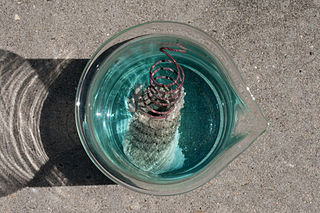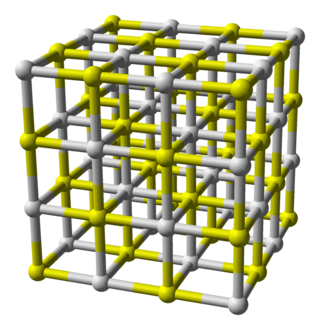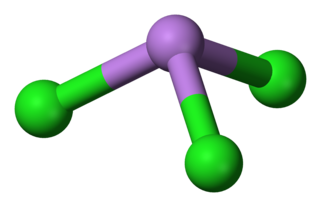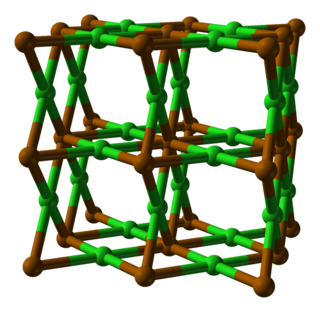Synthesis
1. Passing hydrogen sulfide through an acidic solution of a polonium(II) salt: [6] [7]
2. Reaction of ammonium sulfide aqueous solution with polonium(II) hydroxide:
| Names | |
|---|---|
| Other names Polonium monosulfide [1] | |
| Identifiers | |
3D model (JSmol) | |
| |
| |
| Properties | |
| PoS | |
| Molar mass | 241.07 g/mol |
| Appearance | Black crystals |
| Melting point | 500 °C (932 °F; 773 K) |
| Insoluble [2] | |
| Related compounds | |
Related compounds | Chromium(III) sulfide |
Except where otherwise noted, data are given for materials in their standard state (at 25 °C [77 °F], 100 kPa). | |
Polonium sulfide is an inorganic compound of polonium and sulfur with the chemical formula PoS. [3] The compound is radioactive and forms black crystals. [4] [5]
1. Passing hydrogen sulfide through an acidic solution of a polonium(II) salt: [6] [7]
2. Reaction of ammonium sulfide aqueous solution with polonium(II) hydroxide:
Polonium sulfide forms black solid crystals, insoluble in water, ammonium sulfide, ethanol, acetone, or toluene.
Polonium sulfide has strong reducing properties and can be oxidized by chlorine water, bromine water, sodium hypochlorite, and aqua regia. Polonium sulfide is also unstable to heating. It decomposes into elemental polonium and elemental sulfur when heated to 274.85°C in a vacuum: [8]
Reacts with concentrated acids:
Used in the isolation and purification of polonium.

In chemistry, an acid–base reaction is a chemical reaction that occurs between an acid and a base. It can be used to determine pH via titration. Several theoretical frameworks provide alternative conceptions of the reaction mechanisms and their application in solving related problems; these are called the acid–base theories, for example, Brønsted–Lowry acid–base theory.
Classical qualitative inorganic analysis is a method of analytical chemistry which seeks to find the elemental composition of inorganic compounds. It is mainly focused on detecting ions in an aqueous solution, therefore materials in other forms may need to be brought to this state before using standard methods. The solution is then treated with various reagents to test for reactions characteristic of certain ions, which may cause color change, precipitation and other visible changes.

A single-displacement reaction, also known as single replacement reaction or exchange reaction, is an archaic concept in chemistry. It describes the stoichiometry of some chemical reactions in which one element or ligand is replaced by atom or group.
In chemistry, disproportionation, sometimes called dismutation, is a redox reaction in which one compound of intermediate oxidation state converts to two compounds, one of higher and one of lower oxidation states. The reverse of disproportionation, such as when a compound in an intermediate oxidation state is formed from precursors of lower and higher oxidation states, is called comproportionation, also known as synproportionation.

Calcium sulfide is the chemical compound with the formula CaS. This white material crystallizes in cubes like rock salt. CaS has been studied as a component in a process that would recycle gypsum, a product of flue-gas desulfurization. Like many salts containing sulfide ions, CaS typically has an odour of H2S, which results from small amount of this gas formed by hydrolysis of the salt.

Sodium sulfide is a chemical compound with the formula Na2S, or more commonly its hydrate Na2S·9H2O. Both the anhydrous and the hydrated salts in pure crystalline form are colorless solids, although technical grades of sodium sulfide are generally yellow to brick red owing to the presence of polysulfides and commonly supplied as a crystalline mass, in flake form, or as a fused solid. They are water-soluble, giving strongly alkaline solutions. When exposed to moist air, Na2S and its hydrates emit hydrogen sulfide, an extremely toxic, flammable and corrosive gas which smells like rotten eggs.

Sodium thioantimoniate or sodium tetrathioantimonate(V) is an inorganic compound with the formula Na3SbS4. The nonahydrate of this chemical, Na3SbS4·9H2O, is known as Schlippe's salt, named after Johann Karl Friedrich von Schlippe (1799–1867). These compounds are examples of sulfosalts. They were once of interest as species generated in qualitative inorganic analysis.

Disulfur dichloride is the inorganic compound of sulfur and chlorine with the formula S2Cl2. It is an amber oily liquid.

Arsenic trichloride is an inorganic compound with the formula AsCl3, also known as arsenous chloride or butter of arsenic. This poisonous oil is colourless, although impure samples may appear yellow. It is an intermediate in the manufacture of organoarsenic compounds.

Selenium compounds are compounds containing the element selenium (Se). Among these compounds, selenium has various oxidation states, the most common ones being −2, +4, and +6. Selenium compounds exist in nature in the form of various minerals, such as clausthalite, guanajuatite, tiemannite, crookesite etc., and can also coexist with sulfide minerals such as pyrite and chalcopyrite. For many mammals, selenium compounds are essential. For example, selenomethionine and selenocysteine are selenium-containing amino acids present in the human body. Selenomethionine participates in the synthesis of selenoproteins. The reduction potential and pKa (5.47) of selenocysteine are lower than those of cysteine, making some proteins have antioxidant activity. Selenium compounds have important applications in semiconductors, glass and ceramic industries, medicine, metallurgy and other fields.
A polysulfane is a chemical compound of formula H2Sn, where n > 1. Compounds containing 2 – 8 sulfur atoms have been isolated, longer chain compounds have been detected, but only in solution. H2S2 is colourless, higher members are yellow with the colour increasing with the sulfur content. In the chemical literature the term polysulfanes is sometimes used for compounds containing −(S)n−, e.g. organic polysulfanes R1−(S)n−R2.
Thiosulfuric acid is the inorganic compound with the formula H2S2O3. It has attracted academic interest as a simple, easily accessed compound that is labile. It has few practical uses.

Polonium dichloride is a chemical compound of the radioactive metalloid, polonium and chlorine. Its chemical formula is PoCl2. It is an ionic salt.
Iron(III) sulfide, also known as ferric sulfide or sesquisulfide, is one of the several binary iron sulfides. It is a solid, black powder that degrades at ambient temperature.

Polonium dioxide (also known as polonium(IV) oxide) is a chemical compound with the formula PoO2. It is one of three oxides of polonium, the other two being polonium monoxide (PoO) and polonium trioxide (PoO3). It is a pale yellow crystalline solid at room temperature. Under lowered pressure (such as a vacuum), it decomposes into elemental polonium and oxygen at 500 °C. It is the most stable oxide of polonium and is an interchalcogen.

Sodium polysulfide is a general term for salts with the formula Na2Sx, where x = 2 to 5. The species Sx2−, called polysulfide anions, include disulfide (S22−), trisulfide (S32−), tetrasulfide (S42−), and pentasulfide (S52−). In principle, but not in practice, the chain lengths could be longer. The salts are dark red solids that dissolve in water to give highly alkaline and corrosive solutions. In air, these salts oxidize, and they evolve hydrogen sulfide by hydrolysis.
Tungsten trisulfide is an inorganic compound of tungsten and sulfur with the chemical formula WS3. The compound looks like chocolate-brown powder.

Chromium(II) sulfide is an inorganic compound of chromium and sulfur with the chemical formula CrS. The compound forms black hexagonal crystals, insoluble in water.
Polonium tetraiodide is a binary inorganic compound of polonium and iodine with the chemical formula PoI
4. The compound forms volatile black crystals.

Disulfur diiodide is an unstable inorganic chemical compound with the chemical formula S2I2. It is a red-brown solid that decomposes above −30 °C to elemental sulfur and iodine.